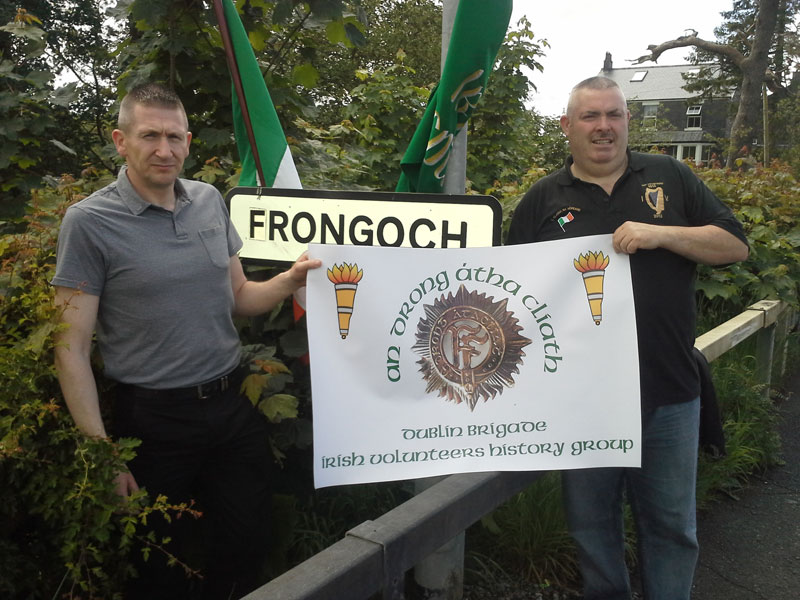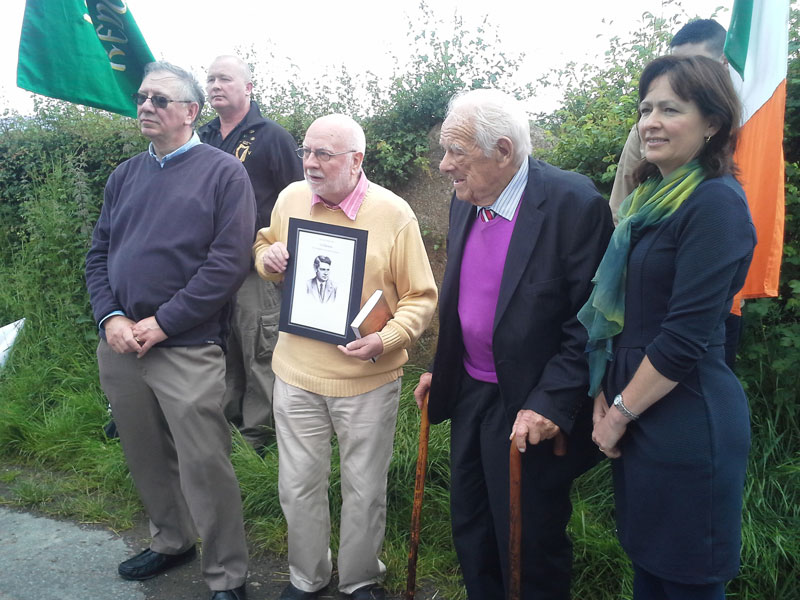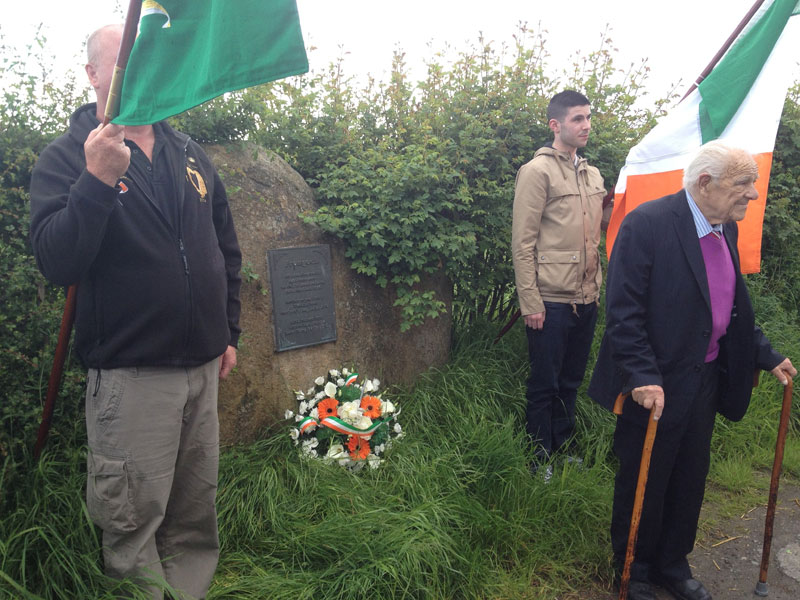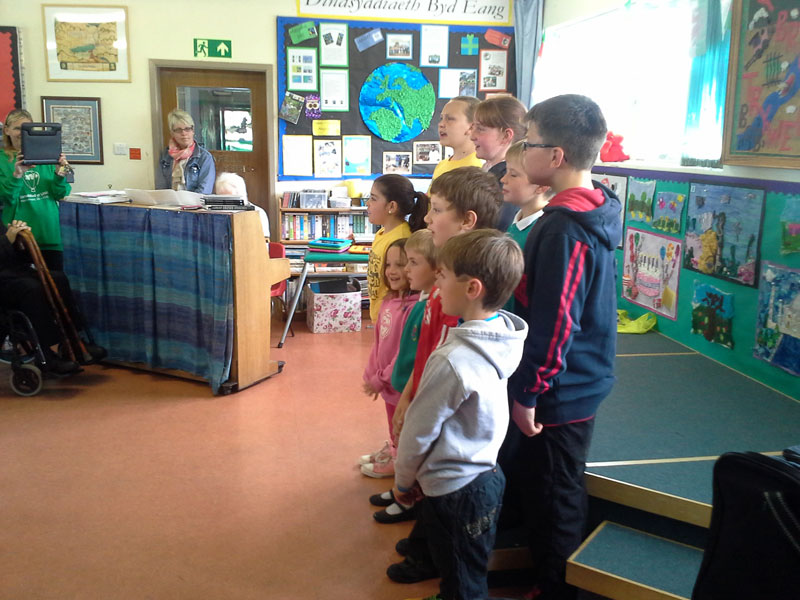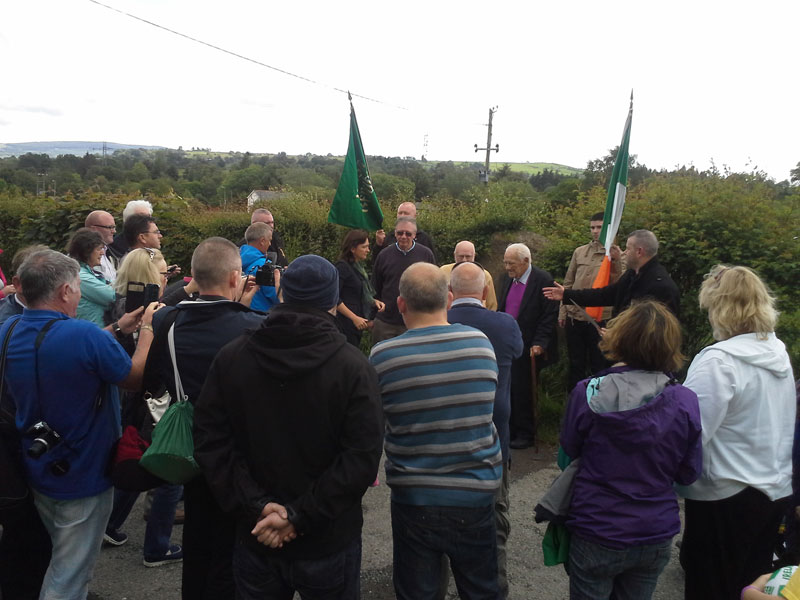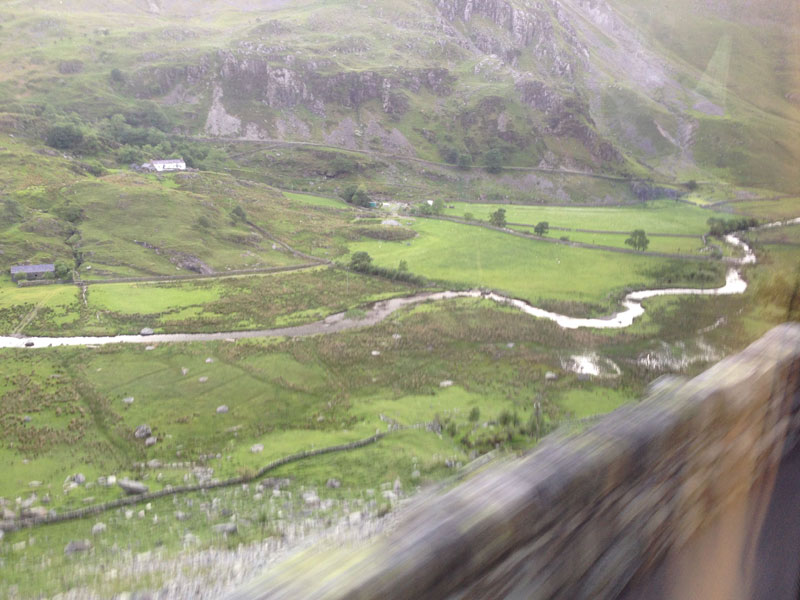Trip to Frongoch
To Wales and Back Again
Although the weather leading up to the Frongoch trip had not been great, nothing could dampen the spirits of a determined group of history buffs from the Collins 22 Society. The long awaited day had finally arrived for our journey to Wales to visit the site where the famous Frongoch Prison once stood. Spearheaded and organised by Paul Fleming, Chairman of the Collins 22 Society Dublin Branch, our group headed off by coach from Liberty Hall at seven that morning to the ferry. After a hearty breakfast on board the ship, and much chat and sharing of stories, we finally arrived at Hollyhead later that morning. At this stage, the weather if anything had become worse, but as we drove on through the picturesque countryside of Wales the weather broke and at last the sun shone for the rest of the day.
When we arrived in Frongoch, the reception that awaited us from old and young alike was overwhelming. The school children and teachers, local residents, reporters and even a future MEP turned out to greet and welcome us. Also in attendance was renowned author and historian Lyn Ebenezer, author of ‘Frongoch Camp 1916, and the birth of the IRA’. Following our warm welcome we were invited into the school which is situated on the site where Frongoch prison once stood. Following an introduction by Paul Fleming inside the school, the children sang two beautiful songs in their native tongue, including the Welsh national anthem. The first thing that struck us all was the passion and pride that these people had in their national language. Although still a part of the United Kingdom, they treasure and love their own unique heritage. I would be moved to say that they are more nationalistic than we are ourselves, especially in pride of language which almost everyone is brought up to learn and love. Having said that, I could not help but feel a connection with these people, who like ourselves, come from a similar and proud ancient Celtic background.
Our guest of honour on the trip was Mr Liam Keogh whose father Ned Keogh was interred here after the Rising. Liam, now almost ninety five years old was accompanied by his three daughters, Helen, Pauline and Patricia. It was with great pride for all of us that Liam accepted our invitation to lay the wreath at the monument on behalf of the society, which commemorates the men of 1916 and the future men and leaders that would go on to fight the War of Independence. His father, Edward ‘Ned’ Keogh was a member of the Irish Citizen Army and later a member of F Coy, 4th Battalion, Dublin Brigade in which my own relatives served. Liam has written an account of his father’s activities during this period which he kindly gave to us and with his kind permission I include at the end of this article.
After our reception in the school, it was banners out and a march to the plaque that marks the site of the prison. Once there, Liam proudly placed the wreath at the foot of the monument. Lyn Ebenezer then gave a speech after which he was presented with a certificate from the Collins22 Society making him an honorary member. Members Paul Callery and Rod Dennison planted a Lilly flower, and a small rose tree which they brought over from the grave of Michael Collins. After our ceremony, it was exploration time, and everyone was free to roam about at their own leisure around the site. Parts of old steel railings and railway lines were still visible in places protruding through the soil. The original railway ticket box was still there and part of the station platform, all situated in someone’s back garden, including the ‘Frongoch Station’ sign. We were also invited into the grounds of the officers’ quarters, a house that is now the home of a family who kindly presented us with a photo of the British Officers who were in charge of the prison posing at that very door for a photo back in 1916/17.
After our adventure it was time for tea and sandwiches which we brought with us. Of course the local coffee shop added to the satisfying of our hunger with their fine supply of fresh country pies and pastries. Following our well-deserved lunch, it was time to board the coach, say our farewells and head for the boat back to Ireland. The trip back was great, where we sat and relaxed and shared stories and memories of the day over a few well deserved pints. It is worth mentioning that the school is in the process of trying to change its name to ‘The Michael Collins National School’ in his honour. What a fitting tribute that would be, and something we would wish to be a part of.
To conclude, after such a successful and interesting trip, we hope to make this a yearly event. Why not come along and join us next time, bring your friends and walk in the footsteps of our patriots, whose hunger for freedom, and determination to achieve it was inspired at this very spot, a place that would later be labelled ‘The University of Revolution’.
By James Langton.
When we arrived back in Ireland, author Lyn Ebenezer mailed Paul Fleming the following:
Paul
Just a note to thank you for your wonderful gesture. I feel honoured to be a member of the Collins 22 Society. To think that I am connected in any way with the great man is a humbling experience. I hope all of you enjoyed your visit and I hope that many more will follow you. Meeting Liam Keogh was in itself a great feeling.
Cheers
Lyn
<————————————————————————–>
NED KEOGH (1896 – 1957)
Introduction:
Although I was born in the Ranch, a district in Inchicore, Dublin, my first awareness of life was in a thatched cottage in Kiltorcan in Ballyhale Parish, County Kilkenny. I lived with my mother, (Ellen, nee Collins) her father, William Collins, also known as Colonel, her sister, Statia and her brother, John. When I was three years of age, my sister was born. So far, I had never heard of my father. I was very happy there and started school in Ballyhale National School. Some of my earliest recollections are, of men with rifles calling to the house. They would stack their rifles inside the door, have a rest and cups of tea and then leave again. It was the time of the Civil War and they were members of the Republican Flying Columns. It was September 1923, that a stranger (to me) walked into the house and as my mother and her sister Stasia rushed out from another room to greet him, I will always remember Stasia’s first words, “well, look who’s here, the old prisoner”. This was my father who was just released from Internment in Hare Park Camp, Curragh. They had been expecting his release from internment but didn’t know exactly when it would happen. A few weeks later, mother, father and sister, Maire and I left Ballyhale for Dublin. When we arrived at Kingsbridge Station (now Heuston), it was almost dark and we got a horse drawn cab to take us to our home in 10 Park Street, Inchicore.
MY FATHER
My father was born in Dublin in the year 1896. He attended the Christian Brothers School in Golden Bridge in Inchicore and left school as soon as it was legal to do so. He worked for the Oblate Fathers as a messenger and later entered the Great Southern Railway Works in Inchicore as a boy labourer. At the time, the Dublin workers suffered very harsh and badly paid conditions. They were completely unorganised and at the mercy of their employers. The Dublin Dockers were paid in Public Houses and were expected to “treat” the Stevedores and many men went home with very little of their wages. About 1908, a Labour Organiser named James Larkin came to Dublin and organised the workers into a Trade Union called the Irish Transport and General Workers Union. With James Larkin came another great labour organiser, James Connolly. The success and growth of the Transport Union alarmed the Dublin employers and 402 of them led by William Martin Murphy (owner of the Irish Independent Newspaper and controller of the Dublin United Tramway Company) banded together and ordered their employees to end their membership of their Union or face dismissal from their employment. When the Union members didn’t comply they were “locked out”, thus began a struggle, which lasted six months.
The authorities in Dublin Castle sided with the employers. They brought the R.I.C (an armed Police Force) to Dublin. They travelled in twos, on whatever trams were running and ‘scabs’ from England were used against the workers. The Dublin Metropolitan Police subjected workers meetings to baton chargers and several injuries were inflicted on the workers. On one occasion, two men were battened to death. One of the biggest baton charges took place in O’Connell Street at this time. Larkin decided it was time to form a force to protect their meetings and he formed an armed unit called the Irish Citizen Army. My father joined this force in 1914. He was a member of the Firing Party over the grave of O’Donovan Rossa in 1915, and stood beside Padraig Pearse as he delivered the oration at the graveside.
My father was employed in the Great Southern and Western Railway Works in Inchicore from May 1912 to Easter Week in April 1916. He obeyed the call to action on Easter Saturday and reported to his unit of Irish Citizen Army at Liberty Hall and on Easter Monday 1916 marched to St Stephen’s Green and fought there under the command of Michael Mallin (who was executed after the surrender on 30th April 1916), second in command of the garrison was Countess Markieviez. After the surrender, he and his comrades were brought to Kilmainham Gaol and then to Richmond Barracks. From Richmond Barracks, he was marched to the North Wall, Dublin and deported and imprisoned in Knutsford Jail in England. After spending a month there, he was removed and interned in Frongoch Concentration Camp in Wales. After about three weeks there, he was sent to Wandsworth Jail to appear before Justice Sankeys Tribunal. After being in Wandsworth for a couple of days, he was sent back to Frongoch where he remained until he was released at the end of August 1916.
When he came home, the Great Southern Railway refused to re-employ him, because of his activities in Easter Week. He was in receipt of 15 shillings per week from the National Aid Association from the time of his release until the 30th November 1916. He undertook temporary employment in Ballyhale, Co. Kilkenny (procured for him by the National Aid Association). He returned at regular intervals to his unit of I.C.A taking part in parades and drills and was available for any military activities if the occasion arose. It was during the period of his employment in Co. Kilkenny that he met my mother and they married in Callan, Co Kilkenny in 1918. (I was born in 1919). He and his wife came to Dublin on the 30th October 1918 and he resumed with his unit in I.C.A. until 31st December 1918 when he transferred to “F” Coy. 4th Battalion, Dublin Brigade I.R.A. He got temporary employment in T & C Martin’s Sawmills until November 1919 and my mother and 7 months old baby had to return to her father in Co. Kilkenny. We returned to Dublin in February 1920 when my father got employment in Richard Martins but we had to go back to Kilkenny again in March 1921. My father was unemployed until May 1922. After a long delay and with the help of Mr. Joseph McGrath (then Minister for Labour in Provisional Government) who acted as intermediary for the 1916 men who were victimised by the G.S.R. were re-instated in May 1922. My father, mother and two children were preparing to settle into normal life again when the Civil War started. My father was in the Four Courts when the Free State Army attacked it.
My mother, baby sister and I had to return to Co. Kilkenny again, where we remained until the end of the civil war in November 1923. My father took the Republican Side during the civil war and while on armed patrol exchanged shots with National Army Officers on Inchicore Road in October 1922. He was arrested the following morning and imprisoned at Wellington Barracks and later transferred to Harepark Camp Curragh. While in Harepark, he assisted in tunnelling operations to enable high profile prisoners to escape. He was on police duty around the camp dining hall and ready to give the signal to the men in the dining hall (who were putting the clay between the floor and the ground) if any of the military were coming around the camp. He took part in a hunger strike in Harepark. His internment lasted from October 1922 until November 1923
IRISH CITIZEN ARMY (INCHICORE SECTION)
The Irish Citizen Army was formed after the 1913 Lock Out in Dublin. Its original intention was to safeguard the workers against the brutality of the armed Police, (the Royal Irish Constabulary). The Headquarters of the Citizen Army was Liberty Hall. A section of the I.C.A was formed in Inchicore which numbered about sixteen men and another section of eight men was formed in Swords. The Liberty Hall section had a couple of hundred volunteers. My father became a member of the Inchicore Section and they drilled in Emmet Hall. The Emmet Hall was the meeting place of the Irish Transport Workers Union, members employed by the G.S.R Railway Works Inchicore. About this time, Mr William Partridge formed a fife and drum band and they also used the hall for their practice sessions. The Inchicore section of the I.C.A didn’t last long so my father joined the band. About two months after he joined the band, the band master left the and Mr. Partridge secured the services of Michael Mallin (who was later executed after the 1916 Rising) who was an accomplished musician as well as a military man.
My father became friendly with Mr. Mallin and during a conversation with him, he told them about the collapse of the Inchicore Branch of the I.C.A. because they had no one capable of training them. Mr. Mallin decided to re-organise the Inchicore section and they drilled with wooden poles and later wooden rifles until they got their share of the German Mausers which were landed in Howth. My father transferred to “F” Company Dublin Brigade I.R.A. in January 1919. He took part in attempted burning of Chapelizod Police Barracks, the escape from Kilmainham Jail, the occupation of Inchicore Railway Works when armoured plating was removed, the attack on British forces at Red Cow, he stood to arms owing to threatened reprisals during 1920-21.
During the truce, he was Company Police Officer for Company Area. He was in charge of armed guard on Irish Transport Union Officials when they were bringing money from Hibernian Bank Inchicore to Emmet Hall and kept an armed guard in the Hall while strike money was being paid to the Transport Union Members who were on strike. He was also on armed guard on a hall in Chapelizod December 1921 when money was being paid out at Christmas. After exchanging shots with National Army Officers on the Inchicore road in October 1922, he was arrested the following morning and imprisoned in Wellington Barracks before being removed to Hare Park Camp in November 1922 and was a prisoner until his release in November 192. His military activities ended on his release as the Civil War was over.
Story of escape from Kilmainham Gaol as told by my father (Ned Keogh), 21st February 1921
Three prisoners, Frank Teeling, Ernie O’Malley and Simon Donnelly were under sentence of death in Kilmainham Gaol. A rescue scheme was devised to enable them escape from Gaol. The I.R.A. had enlisted the help of a gaol warder. A bolt cutter was to be smuggled into the Gaol and the warder would cut the bolt on the main gates of the gaol, so that the gates could be pushed open. The bolt cutter was stolen from the Inchicore Railway Works, but the handles had to be cut off, leaving the shears and two handle stubs. The warder would fit two lengths of gun barrel to the stubs but on the appointed day of the escape, the bolt cutter failed to work, so the attempt to escape had to be postponed. The following day, the warder succeeded in the cutting the bolts of the gates and the prisoners decided to attempt the escape even though there was no organisation on the outside to take them away. They made their way to the tramlines and boarded a tram to College Green and safety.
HARE PARK CAMP ESCAPE
A number of High Profile Republican prisoners awaiting trial were being held between bars. It was decided to attempt an escape by tunnelling from inside the camp under the boundary fence. A hacksaw was smuggled in, as the prisoners would have to cut through iron bars to leave their cells. This would present a problem, as the noise from the saw would attract the attention of the warders. To overcome this difficulty, the other prisoners organised a concert to be held in a hall adjacent to the cells. Anyone who could play a musical instrument was used to form a camp orchestra. The percussionists used bin lids, boxes and anything that made a noise. After every soloist, the orchestra was brought on with a very loud rendering of “Mc Namara’s Band”. When this din was created the prisoners used the hacksaw and succeeded in escaping form the cells and then used the tunnel to get away from the camp.
Ned Keogh was a lifelong member of the G.A.A. and played football with the Geraldine Club. He also acted as their secretary for a period. During his internment in Frongoch, he took part in matches that were organised between the Dublin prisoners and Kerry prisoners. When his playing days were over, he organised a Gaelic Football Club in the parish of Inchicore. It was called St. Michaels G.F.C. it started with under 16 and under 18 teams and those teams went on to become an adult team. All those teams had reasonable success winning South City leagues, minor leagues and Dublin Junior Leagues. During WWII, the club disbanded due to the widespread emigration at the time. In 1941, it was decided to reform a G.A.A. club in Inchicore again and as most of the previous St. Michaels players were now employed in the Great Southern Railworks, in Inchicore, the club would be called the G.S.R. Gaelic Football Club and the Railway Athletic Union would finance the club and provide them with a football ground and a hall to hold functions. Ned Keogh was Chairman of this Club. He also was elected Chairman of the South City Board and later Chairman of Dublin Minor Board.
By Liam Keogh (aged 92 years).
April 2011.
ACCOUNT OF THE EASTER RISING AS TOLD BY NED KEOGH
I was a member of the Inchicore Section of the Citizen Army from early 1914. I took part in all night manoeuvres practising street fighting. I was a member of the guard of honour and firing party at O’Donovan Rossa’s funeral. I took part in the armed guard (2 nights a week) on Liberty Hall from March to Easter Monday 1916. I paraded with the Citizen Army on Easter Sunday evening through Dublin City and halted for a minute at St. Catherine’s Church, Thomas Street, Dublin. We came back to Liberty Hall and James Connolly addressed us in Beresford Place, Dublin and we were confined to Barracks (Liberty Hall) all night.
On Easter Monday, I was sent with a section to Stephen’s Green and dug trenches inside the park (Green) railings. I fought till surrender on Sunday 30th April 1916. On Easter Monday night, I was sent out with a section under Capt. R. McCormack and we attacked Portobello Barracks. On our return, a British Soldier was held up and searched as he was coming out of Harcourt Street Station. When the section returned to the Green (on return from Portobello), I spent the night in the Green which was evacuated the next morning (Tuesday) and we entered the College of Surgeons.
On Tuesday night, I was in a party under Capt. McCormack which kept up continuous firing on the British who were in the buildings on the other side of the Green. This attack on the British was I believe to cover the advance of another party of the Citizen Army who were leaving the College for some operation. During the week, I was in other buildings including the Turkish Baths and the Athletic Stores from which we removed stuff for bedding in the College. We surrendered on Sunday the 30th and were brought as prisoners to the Castle. After an hour or two there, we were sent to Richmond Barracks and the same night (Sunday 30th), we were removed to North Wall and put on a boat and deported. I was sent to Knutsford. After four or five weeks there, I was sent to Frongoch and from there sent to Wandsworth and appeared before the Sankey Tribunal. After being in Wandsworth a couple of days, I was sent back to Frongoch from where I was released at the end of August 1916 and resumed with the Citizen Army. The National Aid got me a job in Co. Kilkenny at the end of 1916 (November 1916), and I took it with one of my comrades who was released at the time I went to it. During the time I was in Kilkenny, I came back to Dublin on and off (four or five times a year – holiday time) and reported to the Citizen Army. I took part in drills and was ready to return if I was called on. I finally came back to Dublin at the end of October 1918 (to work in T and C Martins, North Wall) and resumed drills with the Citizen Army and election protection duties till the end of December 1918, when at the end of December 1918 or early in 1919, I applied for and received a transfer to “F” Coy, 4th Battalion, Dublin Brigade, IRA.
EDWARD KEOGH
10 PARK STREET,
INCHICORE
Archives
Calendar
| M | T | W | T | F | S | S |
|---|---|---|---|---|---|---|
| 1 | 2 | 3 | 4 | 5 | 6 | |
| 7 | 8 | 9 | 10 | 11 | 12 | 13 |
| 14 | 15 | 16 | 17 | 18 | 19 | 20 |
| 21 | 22 | 23 | 24 | 25 | 26 | 27 |
| 28 | 29 | 30 | 31 | |||

